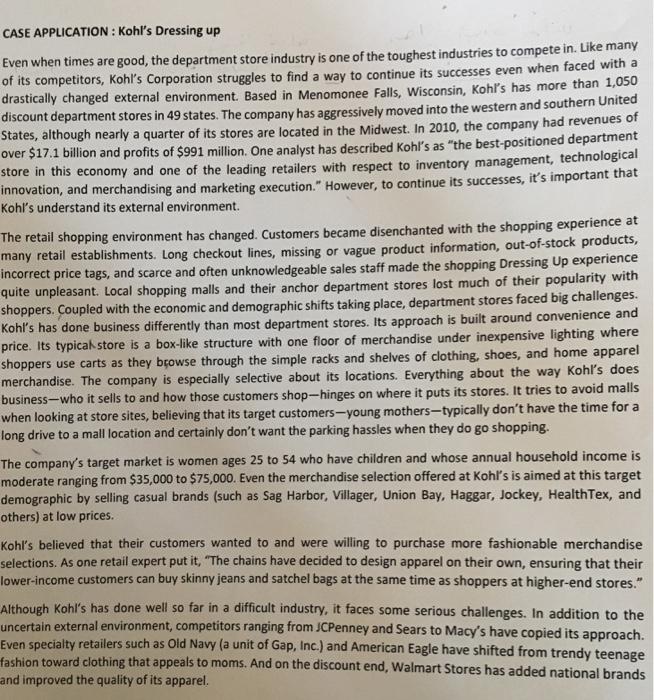Answered step by step
Verified Expert Solution
Question
1 Approved Answer
CASE APPLICATION : Kohl's Dressing up Even when times are good, the department store industry is one of the toughest industries to compete in.


CASE APPLICATION : Kohl's Dressing up Even when times are good, the department store industry is one of the toughest industries to compete in. Like many of its competitors, Kohl's Corporation struggles to find a way to continue its successes even when faced with a drastically changed external environment. Based in Menomonee Falls, Wisconsin, Kohl's has more than 1,050 discount department stores in 49 states. The company has aggressively moved into the western and southern United States, although nearly a quarter of its stores are located in the Midwest. In 2010, the company had revenues of over $17.1 billion and profits of $991 million. One analyst has described Kohl's as "the best-positioned department store in this economy and one of the leading retailers with respect to inventory management, technological innovation, and merchandising and marketing execution." However, to continue its successes, it's important that Kohl's understand its external environment. The retail shopping environment has changed. Customers became disenchanted with the shopping experience at many retail establishments. Long checkout lines, missing or vague product information, out-of-stock products, incorrect price tags, and scarce and often unknowledgeable sales staff made the shopping Dressing Up experience quite unpleasant. Local shopping malls and their anchor department stores lost much of their popularity with shoppers. Coupled with the economic and demographic shifts taking place, department stores faced big challenges. Kohl's has done business differently than most department stores. Its approach is built around convenience and price. Its typical store is a box-like structure with one floor of merchandise under inexpensive lighting where shoppers use carts as they browse through the simple racks and shelves of clothing, shoes, and home apparel merchandise. The company is especially selective about its locations. Everything about the way Kohl's does business-who it sells to and how those customers shop-hinges on where it puts its stores. It tries to avoid malls when looking at store sites, believing that its target customers-young mothers-typically don't have the time for a long drive to a mall location and certainly don't want the parking hassles when they do go shopping. The company's target market is women ages 25 to 54 who have children and whose annual household income is moderate ranging from $35,000 to $75,000. Even the merchandise selection offered at Kohl's is aimed at this target demographic by selling casual brands (such as Sag Harbor, Villager, Union Bay, Haggar, Jockey, HealthTex, and others) at low prices. Kohl's believed that their customers wanted to and were willing to purchase more fashionable merchandise selections. As one retail expert put it, "The chains have decided to design apparel on their own, ensuring that their lower-income customers can buy skinny jeans and satchel bags at the same time as shoppers at higher-end stores." Although Kohl's has done well so far in a difficult industry, it faces some serious challenges. In addition to the uncertain external environment, competitors ranging from JCPenney and Sears to Macy's have copied its approach. Even specialty retailers such as Old Navy (a unit of Gap, Inc.) and American Eagle have shifted from trendy teenage fashion toward clothing that appeals to moms. And on the discount end, Walmart Stores has added national brands and improved the quality of its apparel. Discussion Questions 1. According to the case, what external trends did managers at Kohl's have to deal with? In addition to these, what other external components might be important to these managers? How might they keep track of changes in these components? 2. If you were a manager at Kohl's headquarters, what types of external information might you want? 3. In what cell of the environmental uncertainty matrix would you place Kohl's? Why? How might Kohl's managers "manage" the environmental uncertainty? 4. What stakeholders do you think might be important to a company like Kohl's? What issues/concerns might be important to those stakeholders? Explain your choices.
Step by Step Solution
★★★★★
3.41 Rating (151 Votes )
There are 3 Steps involved in it
Step: 1
1 As per the case dealing with the requirements of the customers can be seen as the main external rends which have to be managed by the managers as the company is related to the global fashion Identif...
Get Instant Access to Expert-Tailored Solutions
See step-by-step solutions with expert insights and AI powered tools for academic success
Step: 2

Step: 3

Ace Your Homework with AI
Get the answers you need in no time with our AI-driven, step-by-step assistance
Get Started


